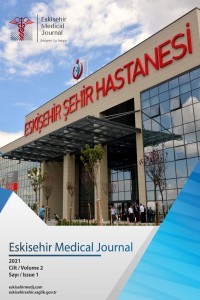Feokromositoma Cerrahisi; 3. Basamak Merkez Deneyimi
feokromositoma, minimal invaziv adrenalektomi, adrenal kitle
PHEOCHROMACYTOMA SURGERY; A TERTIARY CENTER EXPERIENCE
pheochromocytoma, minimally invasive adrenalectomy, adrenal mass,
___
- 1. Bryant J, Farmer J, Kessler LJ, Townsend RR, Nathanson KL. Pheochromocytoma: the expanding genetic differential diagnosis. J Natl Cancer Inst. 2003;95(16):1196-204.
- 2. Amar L, Servais A, Gimenez-Roqueplo AP, Zinzindohoue F, Chatellier G, Plouin PF. Year of diagnosis, features at presentation, and risk of recurrence in patients with pheochromocytoma or secreting paraganglioma. J Clin Endocrinol Metab. 2005;90(4):2110-6.
- 3. Beard CM, Sheps SG, Kurland LT, Carney JA, Lie JT. Occurrence of pheochromocytoma in Rochester, Minnesota, 1950 through 1979. Mayo Clin Proc. 1983;58(12):802-4.
- 4. Young WF Jr. Adrenal causes of hypertension: pheochromocytoma and primary aldosteronism. Rev Endocr Metab Disord. 2007;8(4):309-20.
- 5. Pacak K, Linehan WM, Eisenhofer G, Walther MM, Goldstein DS. Recent advances in genetics, diagnosis, localization, and treatment of pheochromocytoma. Ann Intern Med. 2001;134(4):315-29.
- 6. Guerrero MA, Schreinemakers JM, Vriens MR, et al. Clinical spectrum of pheochromocytoma. J Am Coll Surg. 2009;209(6):727-32.
- 7. Stein PP, Black HR. A simplified diagnostic approach to pheochromocytoma. A review of the literature and report of one institution's experience. Medicine (Baltimore). 1991;70(1):46-66.
- 8. Neumann HPH, Young WF Jr, Eng C. Pheochromocytoma and Paraganglioma. N Engl J Med. 2019;381(6):552-65.
- 9. Baguet JP, Hammer L, Mazzuco TL, et al. Circumstances of discovery of phaeochromocytoma: a retrospective study of 41 consecutive patients. Eur J Endocrinol. 2004;150(5):681-6.
- 10. Kudva YC, Young WFJ, Thompson GB, Grant CS, van Heerden JA. Adrenal Incidentaloma: An Important Component of the Clinical Presentation Spectrum of Benign Sporadic Adrenal Pheochromocytoma. The Endocrinologist. 1999;9:77-80.
- 11. Welbourn RB. Early surgical history of phaeochromocytoma. Br J Surg. 1987;74(7):594-6.
- 12. Pullerits J, Ein S, Balfe JW. Anaesthesia for phaeochromocytoma. Can J Anaesth. 1988;35(5):526-34.
- 13. Whalen RK, Althausen AF, Daniels GH. Extra-adrenal pheochromocytoma. The Journal of urology. 1992;147:1-10.
- 14. Amar L, Bertherat J, Baudin E, et al. Genetic testing in pheochromocytoma or functional paraganglioma. J Clin Oncol. 2005;23(34):8812-8.
- 15. Sever PS, Roberts JC, Snell ME. Phaeochromocytoma. Clin Endocrinol Metab. 1980;9(3):543-68.
- 16. Serin SO, Güçlü M, Ersoy C, Koray A, Öznur B, İmamoğlu Ş. 10 yıllık feokromasitoma deneyimi ve literatüre bakış. Uludağ Üniversitesi Tıp Fakültesi Dergisi. 2009;35:11-6.
- 17. Latronico AC, Chrousos GP. Extensive personal experience: adrenocortical tumors. J Clin Endocrinol Metab. 1997;82(5):1317-24.
- 18. Lenders JW, Pacak K, Walther MM, et al. Biochemical diagnosis of pheochromocytoma: which test is best? JAMA. 2002 Mar 20;287(11):1427-34.
- 19. Plouin PF, Chatellier G, Rougeot MA, et al. Recent developments in pheochromocytoma diagnosis and imaging. Adv Nephrol Necker Hosp. 1988;17:275-86.
- 20. Sawka AM, Jaeschke R, Singh RJ, Young WF Jr. A comparison of biochemical tests for pheochromocytoma: measurement of fractionated plasma metanephrines compared with the combination of 24-hour urinary metanephrines and catecholamines. J Clin Endocrinol Metab. 2003;88(2):553-8.
- 21. Welch TJ, Sheedy PF 2nd, van Heerden JA, Sheps SG, Hattery RR, Stephens DH. Pheochromocytoma: value of computed tomography. Radiology. 1983;148(2):501-3.
- 22. Han S, Suh CH, Woo S, Kim YJ, Lee JJ. Performance of 68Ga-DOTA-Conjugated Somatostatin Receptor-Targeting Peptide PET in Detection of Pheochromocytoma and Paraganglioma: A Systematic Review and Metaanalysis. J Nucl Med. 2019;60(3):369-76.
- 23. Janssen I, Chen CC, Millo CM, et al. PET/CT comparing (68)Ga-DOTATATE and other radiopharmaceuticals and in comparison with CT/MRI for the localization of sporadic metastatic pheochromocytoma and paraganglioma. Eur J Nucl Med Mol Imaging. 2016;43(10):1784-91.
- 24. Gökhaner MŞ. İntraoperatif Malign Hipertansiyon ile Ortaya Çıkan Feokromasitoma Olgusunda Anestezi Yönetimi. Çağdaş Tıp Dergisi.2016;6:360-4.
- 25. Buitenwerf E, Osinga TE, Timmers HJLM, et al. Efficacy of α-Blockers on Hemodynamic Control during Pheochromocytoma Resection: A Randomized Controlled Trial. J Clin Endocrinol Metab. 2020;105(7):2381–91.
- 26. Lenders JW, Duh QY, Eisenhofer G, et al. Pheochromocytoma and paraganglioma: an endocrine society clinical practice guideline. J Clin Endocrinol Metab. 2014;99(6):1915-42.
- 27. Nehs MA, Ruan DT. Minimally invasive adrenal surgery: an update. Curr Opin Endocrinol Diabetes Obes. 2011;18(3):193-7.
- 28. Nomine-Criqui C, Brunaud L, Germain A, et al. Robotic lateral transabdominal adrenalectomy. J Surg Oncol. 2015;112(3):305-9.
- 29. Aliyev S, Karabulut K, Agcaoglu O, et al. Robotic versus laparoscopic adrenalectomy for pheochromocytoma. Ann Surg Oncol. 2013;20(13):4190-4.
- 30. Bihain F, Klein M, Nomine-Criqui C, Brunaud L. Robotic adrenalectomy in patients with pheochromocytoma: a systematic review. Gland Surg. 2020;9(3):844-848.
- 31. Tuncel A, Balcı M, Köseoğlu E, et al. Transperitoneal laparoscopic adrenalectomy: five years' experience with 35 patients. Turk J Urol. 2013;39(4):214-9.
- 32. Bravo EL. Pheochromocytoma: new concepts and future trends. Kidney Int. 1991;40(3):544-56.
- ISSN: 2718-0948
- Yayın Aralığı: Yılda 3 Sayı
- Başlangıç: 2020
- Yayıncı: Eskişehir Şehir Hastanesi
Osman PİRHAN, Sinan AŞAR, Bahar PEHLİVAN, Önder KAYA, İbrahim Faruk AKTÜRK, Fethi KILIÇASLAN, Ercan AKŞİT
Dilek TOP KARTİ, Neslihan EŞKUT, Özge YILMAZ KÜSBECİ
Ağır Astımda Serum Periostin ve IL-13 Düzeylerinin Kan Eozinofilisini Belirlemedeki Etkinlikleri
Ali ÇONER, Emre ERTURK, Salih KILIÇ, Uğur TÜRK
Feokromositoma Cerrahisi; 3. Basamak Merkez Deneyimi
Dursun Burak ÖZDEMİR, Hayrettin DİZEN, Ahmet KARAYİĞİT, Bülent ÜNAL
Bir Eğitim Programının Menopoz Bilgi Düzeyine Etkisi
Yeliz KAYA, Dilek ŞAYIK, Muzaffer BİLGİN
Şiddetli Nekrotizan Fasiit: Olgu Sunumu
Arda Şakir YILMAZ, Bartu BADAK, Ahmet Ümit CEBECİ
Kübital Tünel Sendromuna Neden Olan Ulnar Schwannom: Olgu Sunumu
Turan KANDEMİR, Zeki Serdar ATAİZİ, Müge SEZER
Adrenokortikal Karsinom, Tek Merkez 5 Yıllık Deneyim
Hayrettin DİZEN, Dursun Burak ÖZDEMİR, Ahmet KARAYİĞİT, Bülent ÜNAL
